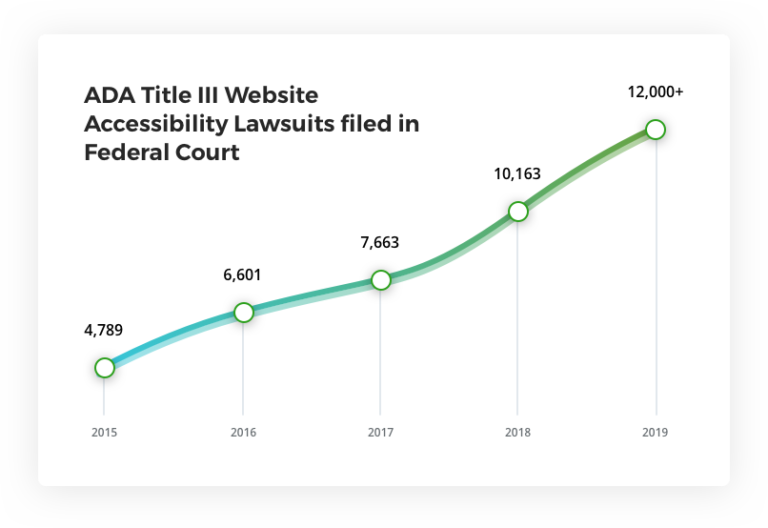It's Time to Get WISE.
Patrick Dillon
CEO
Matthew Hinkle
Director of Accounts
Apply Today
Please fill out the information below. Someone on our team will reach out in 3-5 business days to schedule a call if we see a good fit.
Book Patrick Dillon
Thanks for your interest in booking WISE CEO Patrick Dillon on your podcast! Please complete the form below, and a team member will contact you shortly.

Remove Negative Reviews.
Making Your Website ADA Compliant & Accessible to All

November 20, 2019
- 7 min read

ADA Compliance & Websites
If you’re a business owner, you need to think about your website like you would think about your physical space. You want to make a good impression, be found easily, stand out from the competition, and be accessible to all potential customers—including those with disabilities.
What does ADA have to do with websites?
The American with Disabilities Act (ADA) became law in 1990, and was designed to help bring access to people with disabilities. The ADA is a civil rights law that prohibits discrimination against individuals with disabilities in all areas of public life, including jobs, schools, transportation, and all public and private places that are open to the general public.
Websites, just like your physical business or any other product or service made available to the general public, need to be accessible to people with disabilities like the blind and deaf. This means they need to be coded in a way to work with assistive technologies like screen readers that help people with disabilities digest your website’s content.
To many, this may seem like a shakedown similar to ADA lawsuits many businesses have seen in the past few decades. However, it is not a joke. It’s here to stay, and there is no chance you’ll be able to fight it should you receive a demand letter, or a suit be filed against you for not having a website that is accessible to people with disabilities.
For a great synopsis on the issues facing businesses large and small alike, NBC 8 in Tampa recently put out some great video coverage on the problem business owners are facing here.
Who does it really affect?
Every business is at risk for the most part, but especially high-traffic businesses like restaurants and retail. However, we’re also seeing this across websites that offer and promote professional services, home improvement and more.
Technically speaking, businesses that fall under Title I (those that operate 20 or more weeks per year with at least 15 full-time employees) or Title III (those that fall under the category of “public accommodation”) are covered by the ADA and must have an ADA-compliant website.
How often are businesses being checked/served a lawsuit?
The risk here is great. It’s important to understand that failure to have an ADA compliant website could open your business up to a demand letter, lawsuit, fines, hefty legal fees, and damage to your brand’s reputation.
The number of cases filed each year nationwide continues to grow at a steady pace. The graph below shows this dramatic rise in federal case filings across the nation.
ADA Title III Website Accessibility Lawsuits filed in Federal Court

[Source]
Case filings vary greatly by state currently, and the number of cases filed at the state level is considerably more and much harder to track. California leads the states in the total number of all ADA Title III lawsuit filings in federal court, by more than double the next state of New York. For a short period in 2018 most case filings in California appeared to be filed at the State level because of a dismissed Federal case against Domino’s Pizza by the Central District of California. This dismissal was later reversed, so now both California State and Federal case filings are on the rise again in 2019. For states like California, New York and Florida this means more bad news.
Top 3 States for ADA Title III Federal Lawsuits (January 2019 to June 2019)
- California 2,444
- New York 1,212
- Florida 1,074
We can expect to see the above numbers to more than double before the end of 2019.
More startling is the pace of demand letters, which represents 97% of cases that are settled—that is, cases that are not filed in federal court. This number could be well in excess of 50,000 a year and is expected to continue growing at a faster pace than federal case filings.
How do I find out if my website is accessible?
Developers play an important role in the process of making your website accessible, but as we’ve seen with many other areas of digital marketing, there is a massive gap in education and experience in the development community. ADA compliance being one of the hottest and most current topics in website development means there is even more confusion here.
In short, unless explicitly listed in your website development agreement, or initial Statement of Work (SOW) for your website build, it is very likely that your website is not ADA compliant.
There are two ways to test if your website is accessible.
One, you can use an automated testing tool. These tools are all over the internet. They make it possible to scan your entire website quickly to generate a sophisticated-looking report that gives you an idea of how accessible your website is. Understand though that most of these tests are designed by website development companies who are looking to sell you their services, so expect an endless array of sales calls. Also understand that a lot of these tools sometimes don’t work and aren’t kept up to date, so the scans can both miss significant issues and detect issues that don’t actually have an impact on accessibility. Regardless, using an automated tool should be a part of your process, but understand that no automated testing tool can fully determine if a website is accessible.
Two, work with an Accessibility Subject Matter Expert who can manually test your website and who has the ability to identify accessibility issues on web pages. These people can help make recommendations to your website developers to bring content into accessibility compliance.
What happens if I received a demand letter for not being in compliance?
If you’ve already received a demand letter, you’re going to be facing several significant costs. One is the cost of attorney fees, which could be anywhere from $3,000 to $10,000 or more on both sides. A second is the cost of state-mandated statutory damages (these are the worst in California) which average around $4,000 per incident. The other is the cost to now make your website compliant, which a website development firm can help you understand. However, since you’ve already gotten a demand letter the requirements may be greater than if you had made your website compliant prior to receiving a letter.
You should seek a lawyer immediately and begin the process of remediation (fixing your website to be ADA compliant). Seek out a firm like WISE Digital Partners, which has expertise and experience in making websites ADA compliant.
What happens if a lawsuit is filed against me?
Again, early resolution is critical. If you’ve only thought about remediation for the first time after getting a demand letter, you’re likely going to face higher litigation costs because you have no ground to stand on. If the case settles quickly you may be looking at attorney fees of only $5,000 to $10,000, but if you were to litigate a case through trial, your legal fees could be in well excess of $100,000.
Remember that you’re not just facing your own legal fees and potential fines. You’re also facing plaintiff’s counsel fees, which the plaintiff is entitled to under the ADA. These attorney’s fees can often be higher than your own because it’s part of the cost of them bringing the litigation. Fees here are also based on a per website basis, so if your business has multiple websites, you could be facing very serious legal expenses.
We had a prospective client in California come to us recently who owns multiple businesses and multiple websites. A case was filed against them that resulted in $45,000 in legal fees to resolve – and that is prior to any digital remediation. Because the case was filed with the State and settled, they now have a much higher burden of accessibility to reach and adhere to, and they will have ongoing fees to support their monitoring efforts. You don’t want to risk being in a situation like this.
How do you fix a website?
An experienced firm like WISE Digital Partners can come in and audit any website to see how much accessibility work is required to help bring you into compliance. If we find that we can help improve accessibility, we charge a 1-time setup fee for this service, and then an ongoing monthly management fee to help keep it compliant.
What’s involved ongoing to keep it in compliance?
Something is accessible when people say it is. At the end of the day, if you’re not keeping tabs on this, and someone with a disability says they are unable to use your website, then you could face the risk of the ADA. That’s why working with a partner that will stay on to help you maintain accessibility is the right choice. If you have any questions about making your website ADA-compliant, don’t hesitate to reach out.
Share
Subscribe to WISE Insights
Stay ahead of the digital marketing curve and never miss a lucrative trend or insightful tidbit – subscribe to our WISE blog!
Keep Reading
Build. Grow. Soar.
Get WISE about digital marketing with advanced services, industry experts, and cutting-edge tools designed for long-term, sustainable growth.







